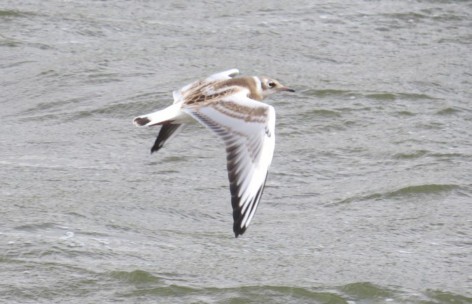Wayne R. Petersen

Jim Sweeney
In this issue readers are once again challenged by a gull—a fact made obvious by the combination of the bird’s fairly broad, pointed wings with a strong upperwing pattern set against a medium gray background; an extensive brown back neatly set off from brownish markings on top of the head and behind the eye by a trim white collar; and a rounded white tail showing a narrow, well-defined dark terminal band contrasting with white uppertail coverts. Although in some ways the mystery bird exhibits a vague resemblance to the plumage of certain tern species, its broad wings, the lack of a dark cap or dark scarf around the back of the head, and the lack of a prominently forked tail should at once remove a tern as an identification option.
Other obvious features of this gull include a slim, bicolored bill, a white leading edge—or wedge—on the upper surface of the wings, and black on the underside of the primaries.
One feature that is particularly important to notice about the mystery gull is the slim, pointed, bicolored bill. Large gulls, e.g., Herring or Great Black-backed gulls, have heavy, laterally compressed bills that typically show a conspicuous gonydeal notch (expansion) on the lower bill (mandible) and are never sharply pointed as the bill on the mystery gull.
Other important features are the light brown back (visible in the online image), upper wing bar, and head pattern coloration. This brown coloration and its presence on the dorsal surface of the gull, along with the bicoloration of the bird’s slim, pointed bill indicate that this individual is a juvenile. In a large gull species, these plumage features would be less clearly defined, especially around the head and on the wings, and the tail band would be broader but ill defined. Also, typically the uppertail coverts would be heavily patterned, not pure white as in the gull in the photograph.
With these points in mind, especially the pointed bill, white wedge on the leading edge of the upper wing surface, and the well-defined black band on the slightly rounded tail, this juvenile gull can only be a Bonaparte’s Gull or a Black-headed Gull. Since Bonaparte’s Gulls always have a sharp-pointed all black bill, white—not black—under their primaries, and seldom show such a clearly defined white collar contrasting with the brownish head pattern on this gull, it is safe to assume that the mystery gull is a juvenile Black-headed Gull (Chroicocephalus ridibundus)—in a plumage rarely seen in Massachusetts, but nonetheless completely distinctive because of these features.
The Black-headed Gull is an uncommon and somewhat local species in coastal Massachusetts. The gull tends to be most frequent in areas where Bonaparte’s Gulls concentrate. Newburyport Harbor, Plymouth, several localities on Cape Cod, and Nantucket seem to be favored spots in recent years, even though the species occasionally shows up elsewhere. Black-headed Gulls are most frequently encountered in spring, fall, and winter, although occasionally nonbreeding immatures linger along the coast in summer. Remarkably, there is also a record of a pair that unsuccessfully attempted to nest at Monomoy National Wildlife Refuge in 1986. Jim Sweeney photographed this Black-headed Gull in Iceland on July 8, 2014.
Wayne R. Petersen